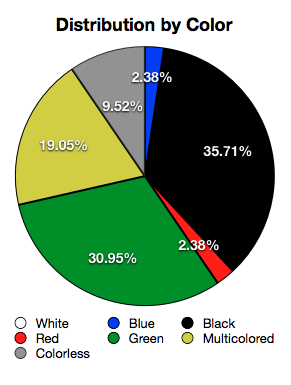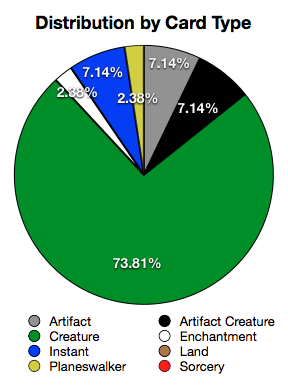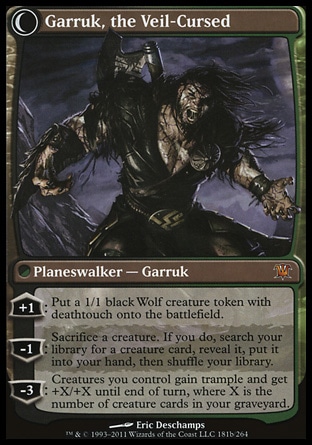Evergreens with Mistergreen - Deathtouch
Features
mistergreen527
29 November 2011
4381 views
29 November 2011
4381 views

Winter is definitely upon us. I live in the Midwest, and here, most trees have lost their leaves. However, some trees are still green: the evergreens. Evergreen trees (also known as pine trees) do not lose their needles during winter. They stay green all year long.
In Magic, some abilities come and go when the year changes. As new blocks are released, some abilities are packed away. Maybe they'll appear again in the future. Maybe they won't. However, some abilities are used year after year. Every Magic set has access to them. These abilities are known as evergreens.
I thought it might be fun to take a look at these abilities that we see year-round, set after set. What a better time to do that than while the evergreens outside are thriving among the bare leaves of their brethren?
Today, we take a look at deathtouch!
The Rules of Deathtouch
First, let's first take an in-depth look of the rules behind deathtouch. Below, you'll see deathtouch's section of the Comprehensive Rulebook. After each ruling, I've put a comment in parentheses that will help you further understand the ruling.
702.2. Deathtouch
702.2a Deathtouch is a static ability.
(Deathtouch is an ability that does something all of the time rather than being activated or triggered.)
702.2b Any nonzero amount of combat damage assigned to a creature by a source with deathtouch is considered to be lethal damage, regardless of that creature's toughness. See rules 510.1c–d.
(When assigning damage to blockers during combat, one damage from a creature with deathtouch is considered lethal. This is important during interactions where a creature with deathtouch is blocked by multiple creatures or if a creature with deathtouch also has trample.)
702.2c A creature with toughness greater than 0 that's been dealt damage by a source with deathtouch since the last time state-based actions were checked is destroyed as a state-based action. See rule 704.
(The game automatically checks for creatures that have taken damage from a creature with deathtouch and destroys them. State-based actions do no use the stack.)
702.2d The deathtouch rules function no matter what zone an object with deathtouch deals damage from.
(If a card in any zone, such as the graveyard, has deathtouch and deals damage to a creature, the deathtouch ability is applied. For example, if a Selfless Exorcist targets a Typhoid Rats card in a graveyard, the Selfless Exorcist will be destroyed.)
702.2e If an object changes zones before an effect causes it to deal damage, its last known information is used to determine whether it had deathtouch.
(For example, if a Prodigal Pyromancer that was equipped with Gorgon Flail dies while its ability is on the stack, since it was last seen on the battlefield equipped with Gorgon Flail, it will still have deathtouch and the damage dealt by its ability will be lethal to the creature it damages.)
702.2f Multiple instances of deathtouch on the same object are redundant.
(If a creature has two or more instances of deathtouch on it, it is treated the same way as if it only had one instance of deathtouch on it.)
The History of Deathtouch
Now that we thoroughly understand what deathtouch is, let's take a look at where it came from. Before we get to the actual deathtouch keyword that we know and love today, let's start at the beginning. Way back when Limited Edition Alpha was released (August 1993), there were two creatures known as Cockatrice and Thicket Basilisk. Both cockatrices and basilisks are mythological creatures that are said to have the ability to turn you into stone if you lock eyes with it. To represent this flavor-wise, Cockatrice and Thicket Basilisk can destroy any non-Wall creature that encounters it in combat. The non-Wall restriction adds to the flavor, since Wall creatures weren't living.


Ten months later, Infernal Medusa was released in Legends (June 1994). Medusas share the stony glare ability that cockatrices and basilisks have, so flavor-wise this made sense. The ability was also given to Abomination to show that they were especially dangerous to green and white creatures. With this release, some of the design space behind the mechanic was also expanded upon and placed on Infinite Authority.



During The Dark (August 1994), the design space and flavor of the "basilisk" ability was further expanded upon when it was placed on an Aura. Venom allowed you to turn any creature into a Thicket Basilisk and showed us that you didn't have to be able to turn things into stone to gain this ability. Being particularly poisonous warranted the mechanic.

When Ice Age (June 1995) was released ten months later, it brought us Kjeldoran Frostbeast and Venomous Breath. Kjeldoran Frostbeast, based on the flavor text, was extremely dangerous when in "proximity," so it makes sense that the "basilisk" ability would be given to it. Venomous Breath continued to spread the mechanic to other card types, by sharing it with Instants.


Dread Specter and Rock Basilisk were both released in Mirage (October 1996). While these two cards, did not expand much on the "basilisk" mechanic, it brought an exciting addition that brings us closer to the deathtouch we use today: Acidic Dagger. While Acidic Dagger still relied on combat, it required that damage was dealt in order for the other creature to be destroyed. Acidic Dagger was also a very flavorful card. It kept the non-Wall text that was present in the original Cockatrice and Thicket Basilisk and presented a way for a creature to use a weapon before Equipment was around.

The next set in the Mirage block, Visions (February 1997) took a different take on the damage equals death idea. Mortal Wound made it so that any amount of damage killed a creature. It wasn't restricted to combat damage, but was a little reversed from deathtouch. Instead of granting a positive ability to one of your creatures, it granted a negative ability to one of your opponent's creatures. Still, you can see some of deathtouch's roots here.

After several incarnations of the abilities found on Thicket Basilisk, Acidic Dagger, and Mortal Wound throughout the years, the first card with the actual "deathtouch" text was printed in Future Sight (May 2007): Thornweald Archer. It's flavor text even included a throwback to its origins, "Their arrows are tipped with basilisk eyes and fletched with cockatrice feathers." It seems it's always been important for deathtouch to be a very flavorful mechanic.

Since appearing on Thornweald Archer, deathtouch has appeared on a card in every set, except for Tenth Edition (July 2007) and Shadowmoor (May 2008). However, the rules behind it used to be slightly different. As we saw earlier in Rule 702.2a, deathtouch is now a static ability. However, it used to be a triggered ability. When the keyword was first created, the reminder text said, "Whenever this creature deals damage to a creature, destroy that creature." Deathtouch would trigger after the creature dealt damage to another creature. This caused some counter-intuitive interactions to occur, such as having to regenerate twice after taking lethal damage from a creature with deathtouch. With the rules changes that coincided with the release of Magic 2010 (July 2009), deathtouch became a static ability and took the form that we still use today. Now, state-based effects do all of the work and make it a much cleaner ability. The reminder text as seen on one of our most recent deathtouch cards, Typhoid Rats (September 2011), now says, "Any amount of damage this deals to a creature is enough to destroy it." Cards that shared the wording of the original deathtouch reminder text, but did not actually have the deathtouch keyword, such as Venomous Fangs (October 1998) and Cruel Deceiver (October 2004), remained as triggered abilities.
Although deathtouch is now an evergreen keyword, you can still see previous incarnations of the ability in today's Standard environment. Compare Thicket Basilisk (August 1993) and Tangle Asp (June 2004) to Engulfing Slagwurm (October 2010) and Wooden Stake (September 2011). Also, compare Acidic Dagger (October 1996) and Stinkweed Imp (October 2005) to Creepy Doll (September 2011).





What other deathtouch-related flavor have you seen on cards?
Notable Deathtouch Cards
Next, let's take a look at some landmark deathtouch cards.
 |
Thornweald Archer (May 2007) was the first card with deathtouch. It was also the first deathtouch creature to have reach. |
| Lace with Moonglove (October 2007) was the first instant to give a creature deathtouch. |  |
 |
Wren's Run Packmaster (October 2007) was the first creature to give other creatures deathtouch. |
| Moonglove Changeling (February 2008) was the first creature to gain deathtouch through an activated ability. |  |
 |
Gift of the Deity (July 2008) was the first Aura to give a creature deathtouch. |
| Quietus Spike (October 2008) was the first Equipment to give a creature deathtouch. |  |
 |
Tidehollow Strix (October 2008) was the first deathtouch creature with flying. |
| Pestilent Kathari (February 2009) was the first deathtouch creature with first strike. |  |
 |
Winged Coatl (April 2009) was the first deathtouch creature with flash. |
| Vampire Nighthawk (October 2009) was the first deathtouch creature with lifelink. |  |
 |
Glissa, the Traitor (February 2011) was the first legendary creature with deathtouch. |
What's your favorite deathtouch card? What deathtouch card do you think was/is the most monumental release?
Deathtouch Stats
I'm a big numbers guy. I love stats, so I couldn't help but put this section here. If you're interested in distributions and percentages like I am, then enjoy. If not, feel free to skip ahead to the next section. There are currently forty-two cards with deathtouch on them. These charts show how these are distributed by color, card type, and converted mana cost.
Deathtouch Distribution by Color:
 |
White = 0/42 = 0.00% Blue = 1/42 = 2.38% Black = 15/42 = 35.71% Red = 1/42 = 2.38% Green = 13/42 = 30.95% Multicolored = 8/42 = 19.05% U/B = 1/42 = 2.38% G/U = 1/42 = 2.38% B/G = 3/42 = 7.14% U/B/R = 2/42 = 4.76% G/U/B = 1/42 = 2.38% Colorless = 4/42 = 9.52% |
Deathtouch Distribution by Card Type:
 |
Artifact = 3/42 = 7.14% Artifact Creature = 3/42 = 7.14% Creature = 31/42 = 73.81% Enchantment = 1/42 = 2.38% Instant = 3/42 = 7.14% Land = 0/42 = 0.00% Planeswalker = 1/42 = 2.38% Sorcery = 0/42 = 0.00% |
Deathtouch Distribution by Converted Mana Cost:
 |
CMC 0 = 1/42 = 2.38% CMC 1 = 4/42 = 9.52% CMC 2 = 10/42 = 23.81% CMC 3 = 15/42 = 35.71% CMC 4 = 2/42 = 4.76% CMC 5 = 6/42 = 14.29% CMC 6 = 2/42 = 4.76% CMC 7 = 2/42 = 4.76% |
Fun with Deathtouch
Next, let's take a look at some really cool things that you can do with deathtouch.
Deathtouch + First Strike/Double Strike
As we discussed earlier, creatures that take damage from a source with deathtouch are destroyed as a state-based effect. That means if a creature with deathtouch deals first strike damage to a creature without first strike, the creature without first strike will die before it gets to retaliate with damage of its own.
Some cards already have both of these abilities built into them, such as Cairn Wanderer, Glissa, the Traitor, Nirkana Cutthroat, and Pestilent Kathari. Otherwise, you can give deathtouch to any creature with first strike or double strike using cards such as Basilisk Collar, Gorgon Flail, or Onyx Mage. Or, you can give first strike or double strike to any creature with deathtouch using cards such as Battle Mastery, Reflexes, or Viridian Claw.




Deathtouch + Trample
When a creature with trample is blocked, it deals enough combat damage to the blocking creature until it is lethal. When your attacking creature has deathtouch, one damage is lethal. So, it will deal one damage to each blocking creature and the rest will be dealt to the opponent. Obviously, the more power your creature has, the better.
Currently, there are only two cards with these two abilities built into them: Cairn Wanderer and Garruk, the Veil-Cursed
Flip. However, we just mentioned some cards that give deathtouch that you can use on any creature with trample. Or, you can give trample to any creature with deathtouch using cards such as Horned Helm, Primal Frenzy, or Rancor.


Deathtouch + Provoke/"Lure"
By forcing a creature to block one of your creatures with deathtouch, you are essentially using a removal spell. If you can force several of your opponent's creatures to block one of your creatures with deathtouch, you are essentially using several removal spells (as long as your creature has enough power to deal one damage to each of their creatures).
Gift of the Deity and Turntimber Basilisk already contain both of these abilities. Otherwise, you can give deathtouch to any creature with provoke or "lure." Or, you can give provoke or lure to any creature with deathtouch using cards such as Lure, Nemesis Mask, or Seton's Desire.

Deathtouch + "Pinging"
"Pinging" is Magic-speak for a creature with an ability to deal damage to a creature or player, such as Prodigal Sorcerer. If that creature also has deathtouch, everytime it "pings," it will kill off the creature it targeted.
There are currently no cards that have deathtouch and "pinging" built in. You can give any "pinger" deathtouch using any of the cards we mentioned earlier. Or, you can give the pinging ability to any creature with deathtouch using cards such as Power of Fire, Thornbite Staff, or Viridian Longbow.
Deathtouch + "Pestilence"
The "pestilence" ability is named after the card with the same name: Pestilence. Something with "pestilence" deals damage to each creature and each player. Thrashing Wumpus is an example of a creature with "pestilence." If that creature also has deathtouch, it will destroy each creature.
There are currently no cards that have deathtouch and "pestilence" built in. You can give deathtouch to any creature with "pestilence" using the cards we mentioned before. There are currently no cards that grant "pestilence" that you could use on a creature with deathtouch.
Are there any other fun combos you've discovered that involves deathtouch? What's the craziest game you've seen that involved deathtouch? Finally, if you have any deathtouch inspired decks, please feel free to share them!
I hope you've enjoyed taking a look at deathtouch with me. Please let me know if this is the type of article you would like me to continue doing.
I'm personally a fan of adding Deathtouch to Goblin Sharpshooter . It's like a continual Overwhelming Forces or Rain of Daggers without the drawing or life loss.
November 30, 2011 4:27 a.m.
pookypuppy6 says... #3
My favourite mechanic, and this was an excellently written and researched piece.
Reminds me that I made two seperate Deathtouch-related decklists, Deathtouch This(B/G) and Deathtouch This 2(B/R) ; both are examples of the deathtouch/pinger tactic
November 30, 2011 8:58 a.m.
Rhadamanthus says... #4
This was a fantastically written and well researched article, and I look forward to seeing more in the series.
November 30, 2011 10:58 a.m.
mistergreen is back with a whale of an article. thanks!
November 30, 2011 4:19 p.m.
I personally liked Fire Whip with a deathtouch creature.
November 30, 2011 7:09 p.m.
MisterRoach says... #7
My personal favorite is Basilisk Collar on Brigid, Hero of Kinsbaile
December 1, 2011 6:52 p.m.
Typhoid Rats in a deck with Puresteel Paladin and Mortarpod .
December 2, 2011 4:09 p.m.
Vampire Nighthawk is a beast that is amazing, a deck that gives it first strike already has a wincon in it.
December 2, 2011 6:43 p.m.
pookypuppy6 says... #10
I just like Deadly Recluse because it is just that awesome! :D
STG says... #1
Lovely in-depth history and usage of one of my favourite mechanics in the game.
I thought the Deathtouch + Pestilence part was also really nice, I never even thought/heard about those cards.
I for one enjoyed reading this article, and I would look forward to any future ones going into other mechanics. (:
P.S I approve of your use of pie! Pie Charts, that is.
November 29, 2011 11:29 p.m.